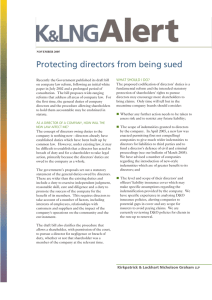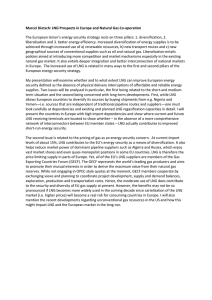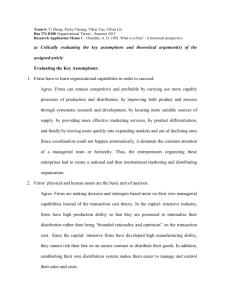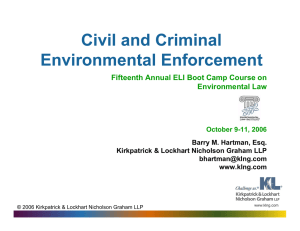T Differentiation Case study: Kirkpatrick & Lockhart Nicholson Graham LLP
advertisement
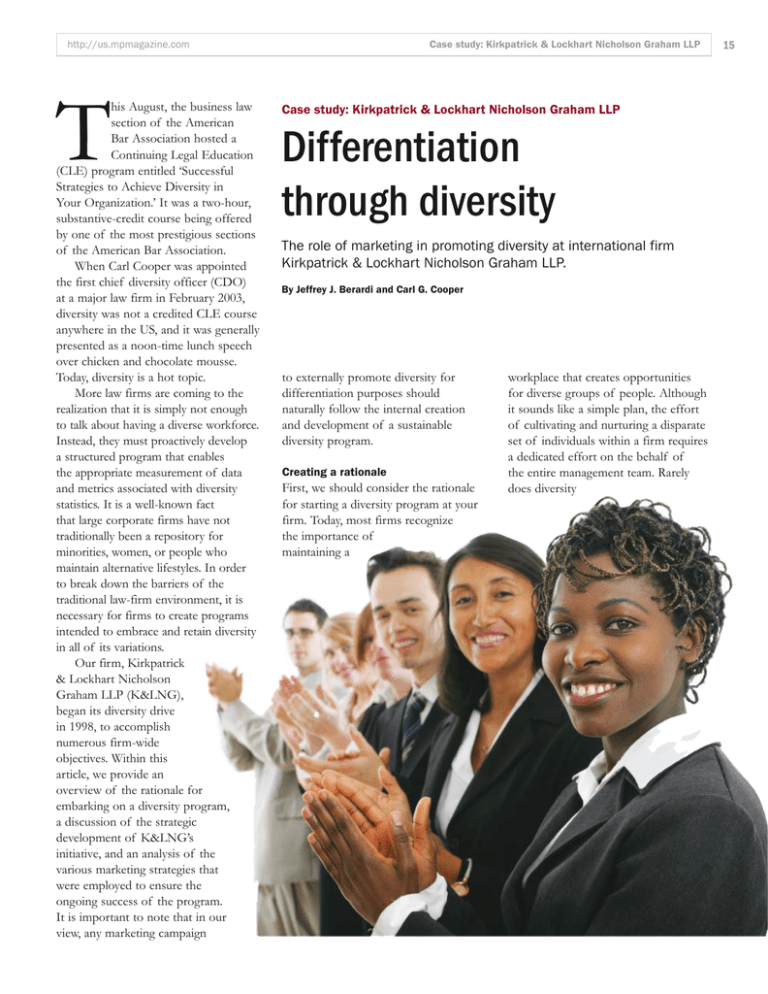
http://us.mpmagazine.com T his August, the business law section of the American Bar Association hosted a Continuing Legal Education (CLE) program entitled ‘Successful Strategies to Achieve Diversity in Your Organization.’ It was a two-hour, substantive-credit course being offered by one of the most prestigious sections of the American Bar Association. When Carl Cooper was appointed the first chief diversity officer (CDO) at a major law firm in February 2003, diversity was not a credited CLE course anywhere in the US, and it was generally presented as a noon-time lunch speech over chicken and chocolate mousse. Today, diversity is a hot topic. More law firms are coming to the realization that it is simply not enough to talk about having a diverse workforce. Instead, they must proactively develop a structured program that enables the appropriate measurement of data and metrics associated with diversity statistics. It is a well-known fact that large corporate firms have not traditionally been a repository for minorities, women, or people who maintain alternative lifestyles. In order to break down the barriers of the traditional law-firm environment, it is necessary for firms to create programs intended to embrace and retain diversity in all of its variations. Our firm, Kirkpatrick & Lockhart Nicholson Graham LLP (K&LNG), began its diversity drive in 1998, to accomplish numerous firm-wide objectives. Within this article, we provide an overview of the rationale for embarking on a diversity program, a discussion of the strategic development of K&LNG’s initiative, and an analysis of the various marketing strategies that were employed to ensure the ongoing success of the program. It is important to note that in our view, any marketing campaign Case study: Kirkpatrick & Lockhart Nicholson Graham LLP Case study: Kirkpatrick & Lockhart Nicholson Graham LLP Differentiation through diversity The role of marketing in promoting diversity at international firm Kirkpatrick & Lockhart Nicholson Graham LLP. By Jeffrey J. Berardi and Carl G. Cooper to externally promote diversity for differentiation purposes should naturally follow the internal creation and development of a sustainable diversity program. Creating a rationale First, we should consider the rationale for starting a diversity program at your firm. Today, most firms recognize the importance of maintaining a workplace that creates opportunities for diverse groups of people. Although it sounds like a simple plan, the effort of cultivating and nurturing a disparate set of individuals within a firm requires a dedicated effort on the behalf of the entire management team. Rarely does diversity 15 16 Case study: Kirkpatrick & Lockhart Nicholson Graham LLP within an organization occur in an organic manner, and the firm’s good intentions regarding its promotion will often be insufficient to fulfill long-term goals. Thus, actually creating a diversity plan for measurement and tracking purposes is a mandatory step for any or other issues. Next, diversity creates broader opportunity in terms of the workforce, staff turnover is reduced, and the result is that you are left with a richer pool of resources to choose from. A diversity program also increases the self-image of the firm More law firms are coming to the realization that it is simply not enough to talk about having a diverse workforce. Instead, they must proactively develop a structured program that enables the appropriate measurement of data and metrics associated with diversity statistics. firm that really wants to follow-through on its defined goals to attract and grow a more heterogeneous organization. Furthermore, in addition to the social responsibilities to consider for implementing a diversity program, we should also think about the increasing number of clients who demand that this is a priority at the firms they select. It is clear that our clients have their own diversity issues that they face in their internal organizational structures, and often these clients also have a high level of expectation that their primary law firms share their diversity values. From a marketing standpoint, we find more and more request-forproposals (RFPs) that specifically ask for background regarding our firm’s diversity efforts. In fact, clients are beginning to request statistics or figures relating to our program, which confirms the idea that simply having a program is not enough. Those firms that do not comply with clients’ expectations may find themselves sitting on the sidelines, rather than competing directly with other firms for business. There are other economic factors that make having a diverse workforce more attractive to firms. For example, a firm that consists of a diverse group of people may be less likely to find itself involved in litigation alleging discrimination based on gender, race, from an internal standpoint, improves motivation of staff, and enables the public to see your firm in a different, and better, light. For all of these reasons and more, a diversity program makes good economic sense. Getting started In 1998, K&LNG hired a consulting firm, Springborg & Associates, to come in and do both a diversity audit and a training program for the firm. It recommended several steps we should take to enhance our workforce and increase our commitment to diversity. For the next five years, the firm nurtured and developed its efforts to http://us.mpmagazine.com was going to be fully integrated into every aspect of the firm’s culture. This resulted in the creation and launch of K&LNG’s diversity initiative, beginning with the creation of the country’s first CDO position. The role was intended not only to operate at the management level internally, but also to act as a change agent for the entire legal profession. K&LNG felt that it was imperative to create a focused program to ensure that we were taking the necessary steps to foster a work environment that acquires, promotes and maintains diversity across the firm. The primary objectives of the K&LNG diversity initiative were threefold. First, we sought to expand recruiting activities to bolster the number of minorities, women, and gay and lesbian lawyers. Second, we developed a firm-wide mentoring program, which included gender and race-specific innovations to enhance retention of these two groups. Third, we sought to promote K&LNG among minority constituencies, as well as promoting awareness of our diversity initiatives to the entire community. In any firm, the first two objectives need to be promoted using a top-down management approach. Without a clear directive from the managing partner, noting the importance of the diversity initiative, it will be difficult to justify the From a marketing standpoint, we find more and more request-for-proposals that specifically ask for background regarding our firm’s diversity efforts. In fact, clients are beginning to request statistics or figures relating to our program, which confirms the idea that simply having a program is not enough. the point where, in early 2003, chairman and managing partner Peter Kalis, along with the management committee, determined that rather than having another standalone program, diversity necessary investment of time, resources and money that a well-planned program requires. The CDO is secondary voice of the diversity initiative to the outside, as well as internal, community. Peter http://us.mpmagazine.com Kalis constantly incorporates his vision of diversity at the firm in every presentation and policy undertaken by the firm. At every firm retreat, management meeting and during formal or informal communications, he never fails to conspicuously include Case study: Kirkpatrick & Lockhart Nicholson Graham LLP In order to get the most recognition for the formal implementation of our program, we decided to launch the announcement of Carl Cooper’s arrival on Martin Luther King Day, January 10, 2003. This timing strategy was critical because the message we were sending was well defined and targeted prior to launch. For example, we focused on diversity publications, we called journalists who wrote on diversity topics and issues, and we took care to make sure we were hitting all the major local, regional and international outlets. Maintaining momentum K&LNG’s message was fairly simple in nature – namely, that diversity is a core value of the firm, and the creation of the firm-wide program reflects our commitment to this value. This message was conveyed in the form of a mission statement, written by Peter Kalis, which was attached to the press release itself. diversity as an essential element of his objectives for the firm. Given that type of leadership, the CDO often merely reflects management’s desire for an inclusive workforce, which in turn symbolizes an integral aspect of the quality of representation that our clients expect. However, it is the third objective, promotion of the initiative, which we will discuss in more detail, because this is the primary area where the marketing department can be utilized to create programs that spread the word to various key groups in targeted business or regional communities. A firm needs to have the building blocks of the first two objectives well in place before it can logically promote its diversity program as a differentiating factor. From a marketing perspective, one of the strongest ways to spread the word about your established diversity program is through a strategic, well-timed, and well-executed publicrelations strategy. Spreading the word Our firm used a distinct timing strategy to distribute information about the initiative. For example, we created an internal diversity program well in advance of any external promotion. to local, national and international media contacts fitted extremely well with the holiday itself, a day dedicated to honoring a man who selflessly dedicated his life to ensuring the equal treatment of all men and women, regardless of race. K&LNG’s message was fairly simple in nature – namely, that diversity is a core value of the firm, and the creation of the firm-wide program reflects our commitment to this value. This message was conveyed in the form of a mission statement, written by Peter Kalis, which was attached to the press release itself. One of the additional benefits of the K&LNG program is that K&LNG promotes the initiative through a combination of electronic newsletters, sponsorships and brochure mailings. These efforts enable the firm to maintain momentum both internally and within the business community. They also serve to ensure that our program is kept current and fresh. For example, we publish a regular diversity newsletter, which is sent out electronically to contacts and clients. In addition to this, we have published a booklet of information, ‘Diversity at K&LNG: A Report to Our Clients’, which is distributed to in-house counsel and clients across the US and UK. The firm constantly looks for ways to support organizations that are aligned with our own goals to grow diversity. We have been the sole sponsor of the James M. Nabrit lecture series at Howard University School of Law for the past three years. This prominent series was initiated in honor of James M. Nabrit, Jr., former president of Howard University and former dean of its law school. We are annual sponsors of the Charting Your Own Course One of the additional benefits of the K&LNG program is that it also helped to increase overall diversity awareness within the business community at large. it also helped to increase overall diversity awareness within the business community at large, and our ongoing efforts in this area continue to achieve that goal. In contrast to a ‘scattershot’ approach, our public-relations strategy (CYOC) corporate career conference, and we send K&LNG lawyers to this conference every year. CYOC was founded by a small group of minority in-house corporate counsel who sought to address the unmet career development needs of 17 18 Case study: Kirkpatrick & Lockhart Nicholson Graham LLP http://us.mpmagazine.com Without setting goals, benchmarks and deliverables, it will be difficult for your firm to track the success of a diversity program. There is always room for improvement and it is never too late to begin formal efforts to increase the number of diverse professionals within your firm. minority lawyers. K&LNG is also a major sponsor of the annual event held by Corporate Counsel Women of Color (CCWC). Formed in 2004, CCWC is a not-for-profit organization of female attorneys of color who serve as general counsel, assistant general counsel, corporate counsel, and in other capacities for various companies in the US and overseas. Demonstrating improvement Without setting goals, benchmarks and deliverables, it will be difficult for your firm to track the success of a diversity program. There is always room for improvement and it is never too late to begin formal efforts to increase the number of diverse professionals within your firm. At K&LNG, we have taken strides to set and track metrics for internal purposes, so that we can understand which aspects are strong and which represent areas for development. Since the CDO took office, the number of minority lawyers in the firm (as defined by the National Association of Law Placement) has grown from 67 to 104 (as of February 2006). The number of minority partners has grown from five to 18; the number of women lawyers has grown from 208 to 261; and the number of women partners has grown from 29 to 46 within that same time period. These numbers outpace the overall growth of the firm during that time frame. Furthermore, almost onethird of the firm’s 2005 fall associate class was of a minority status and nearly half were women. We have also been recognized in the media – Diversity & The Bar magazine noted K&LNG as one of four firms in the US, which is: “… stepping outside the norm, displaying an unprecedented level of commitment and new strategies for achieving diversity.” Changes beyond our own internal efforts have also taken place in the market. Three years after the initiative was created, a group called the Association of Law Firm Diversity Professionals, composed of over 30 full-time diversity directors, managers and officers, is about to be launched. More firms every month are hiring and marketing for diversity officers and professionals from across the country and in the UK. In just over three years, diversity has become a core value, an essential addition to both large and small firms everywhere. To distinguish diversity from programs that had gone on before, practitioners noted that unlike affirmative action, which was reactive, diversity was proactive. Whereas in the past it focused primarily on recruitment; it is currently seen more as a tool for retention and mentoring, relationship building, and community outreach. At K&LNG, we strive to promote, acquire and maintain diversity because we have a responsibility to lead our profession in the right direction in the 21st century. We know diversity is not an end in itself, but a means to an end. Our marketing efforts have built upon and maintained the foundation of a sustainable diversity program, and we have achieved the additional benefit of increasing diversity awareness within the greater business and legal community. The results of our ongoing program will ultimately be measured by a more inclusive workforce, from the bottom-up and from the top-down, and as Peter Kalis often comments, we are determined to stay the course, for our clients’ sake, for our own good, and for the benefit of the profession. Jeffrey Berardi is acting chief marketing officer and Carl Cooper is chief diversity officer at the Boston office of Kirkpatrick and Lockhart Nicholson Graham LLP. They can be contacted at jberadi@klng.com and ccooper@klng.com respectively. need reprints of MP articles? Please e-mail Caroline Poynton with your requests on cpoynton@ark-group.com or telephone +44 (0)20 8785 5938 Published by:


